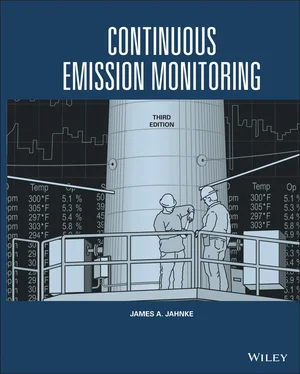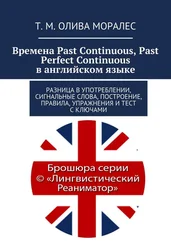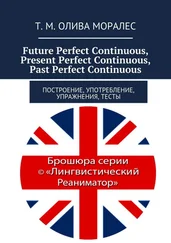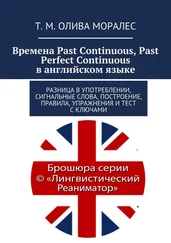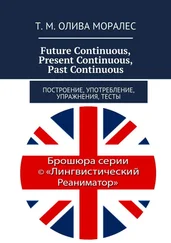James A. Jahnke - Continuous Emission Monitoring
Здесь есть возможность читать онлайн «James A. Jahnke - Continuous Emission Monitoring» — ознакомительный отрывок электронной книги совершенно бесплатно, а после прочтения отрывка купить полную версию. В некоторых случаях можно слушать аудио, скачать через торрент в формате fb2 и присутствует краткое содержание. Жанр: unrecognised, на английском языке. Описание произведения, (предисловие) а так же отзывы посетителей доступны на портале библиотеки ЛибКат.
- Название:Continuous Emission Monitoring
- Автор:
- Жанр:
- Год:неизвестен
- ISBN:нет данных
- Рейтинг книги:4 / 5. Голосов: 1
-
Избранное:Добавить в избранное
- Отзывы:
-
Ваша оценка:
- 80
- 1
- 2
- 3
- 4
- 5
Continuous Emission Monitoring: краткое содержание, описание и аннотация
Предлагаем к чтению аннотацию, описание, краткое содержание или предисловие (зависит от того, что написал сам автор книги «Continuous Emission Monitoring»). Если вы не нашли необходимую информацию о книге — напишите в комментариях, мы постараемся отыскать её.
The new edition of the only single-volume reference on both the regulatory and technical aspects of U.S. and international continuous emission monitoring (CEM) systems Continuous Emission Monitoring
Continuous Emission Monitoring:
Continuous Emission Monitoring, Third Edition
Continuous Emission Monitoring — читать онлайн ознакомительный отрывок
Ниже представлен текст книги, разбитый по страницам. Система сохранения места последней прочитанной страницы, позволяет с удобством читать онлайн бесплатно книгу «Continuous Emission Monitoring», без необходимости каждый раз заново искать на чём Вы остановились. Поставьте закладку, и сможете в любой момент перейти на страницу, на которой закончили чтение.
Интервал:
Закладка:
The acid rain program, NSPS, and air toxics monitoring programs all include requirements for writing a plant‐specific CEM QA plan and periodic performance testing. Although Appendix F applies only to those NSPS sources that use CEM systems for compliance, many states have viewed CEM quality assurance as integral to their own programs and have patterned QA requirements after those of Appendix F. Even if not required to implement a QA program, a source should develop a QA plan if it wishes its CEM data to be legally defensible.
The Role of Calibration Gases
U.S. CEM programs have been written so that gaseous pollutant emission data are traceable to National Institute of Standards and Technology (NIST) standard reference materials (SRMs). Certified calibration gases, traceability back to SRMs, are used for this purpose when conducting the required quarterly cylinder gas audit of Part 60 Appendix F – Procedure 1 and the Part 75 daily calibration verifications and quarterly linearity tests. The traceability protocols are found in the document: EPA Traceability Protocol for Assay and Certification of Gaseous Calibration Standards (U.S. EPA 2012).
In addition to the traceability protocol, the Clean Air Markets Division instituted the Protocol Gas Verification Program (PGVP) designed to ensure the accuracy of protocol calibration gases – a program that has done much to ensure the quality of CEM data [see 40 CFR 75.21(g)(6) and (7)]. To sell gases as “protocol” gases, gas suppliers must adhere to traceability protocol procedures and participate in the PGVP program. In the program, protocol gases are purchased by users, who instead of using them, send the gases to NIST for analysis against NIST standard reference materials. The results of the analyses are made publicly available, which provides an incentive for gas vendors to perform well on the blind audits. Failure to perform well can result in a loss of both credibility and customers in this competitive and lucrative business.
INTERNATIONAL RULES
Internationally, as in the United States, the implementing rules first require the installation of a CEM system, and then procedures for installation and certification are provided either in an appendix to the implementing rule or are given in a separate set of specifications. Either U.S. CEM Performance Specification Test procedures or the EU accreditation and calibration procedures are commonly adopted for CEM system certification by other countries.
Canada
In Canada, the Federal Government provides national guidelines, through Environment Canada, that are to be implemented by the provinces. For example, in May of 1993, National Power Generation Emissions guidelines for New Stationary Sources (N 305) were published to address acid rain control requirements agreed upon in the U.S.– Canada Clean Air Accords. Mercury monitoring requirements are given in the document Canada‐wide Standards for Mercury Emissions (CCME 2006, 2007).
Implementing rules are published separately by the provinces. For example, in Ontario, monitoring requirements for cement plants and smelters are found in Ontario Rule 194/05 (Government of Ontario 2020a). Monitoring requirements for electrical generation are found in Ontario Rule 347/01 (Government of Ontario 2020b).
In Alberta, CEM implementing rules are given in facility “approvals.” Approaches to emission monitoring requirements in other Canadian provinces have been summarized in a report submitted to the Canadian Council of Ministers by Marbek Consultants (Marbek 2009).
CEM system installation, certification, and quality assurance criteria are found in the Environment Canada document EPS/1/PG7 – Protocols and Performance Specifications for Continuous Monitoring of Gaseous Emissions from Thermal Power Generation (ENVC 2005), which is either adopted or modified by the provincial environmental ministries. In Alberta, a “CEMS Code,” based on EPS 1/PG/7, was developed to address petroleum industry and other sources (AEP 1998). The Alberta CEMS Code has also been adopted in Australia (WADER 2016).
Europe
In Europe, directives for installation of CEM systems are issued by the European Parliament and the Council. For example, the Industrial Emissions Directive (EU 2010) requires the Member States of the European Union to develop implementing rules for automated monitoring systems (AMS). CEM certification requirements were standardized by the European Committee for Standardization, i.e., ( Comité Europeén de Normalisation [CEN]) in standards EN 15627 and 14181.
Asia
Both China and India are active in requiring the installation of CEM systems in major stationary sources. In China, an air pollution emissions standard for power plants, requiring the installation of CEM systems, was issued in 1997 (Qingfeng and Yuhong 1997; Sloss 1997). In 2007, China’s Ministry of Environmental Protection issued further requirements for all state‐controlled polluting facilities to install CEM systems by the end of 2008 (Zhang and Schreifels 2011). Certification procedures in China have followed those of U.S. Part 60 and 75, and over 10 000 systems have been reported as being installed (Zhu et al. 2010). The emissions data from these systems have been compared to satellite data (Karplus et al. 2018), a novel method of assessing data quality.
In 2014, the Central Pollution Control Board of India mandated 17 industrial sectors to install CEM systems (CPCB 2018a). This has created a large market in India for both particulate and gas monitoring systems. Certification procedures and data credibility issues are being resolved in this nascent program. Compliance reporting protocols for online continuous emission and effluent monitoring systems (OCEMS) were issued in 2018, which will require the submittal of CEM system design and installation details and real‐time data (CPCB 2018b).
Latin America*
CEM systems in Latin America are typically required to be installed through national emission control programs (Montoya 2020, Morrell 2020).
* The assistance of L. Montoya and S. Morrell in the writing of this section are greatly appreciated.
Mexico
Stationary source emissions in Mexico are regulated by the Secretaria del Medio Ambiente y Recursos Naturales (SEMARNAT – Secretariat of the Environment and Natural Resources). CEM systems were required in 1995 for glass manufacturing plants for monitoring NO x, CO, and O 2. CEM systems for monitoring NO xand O 2were required for large thermoelectric plants in 1995, and SO 2and opacity monitors were required in a 2011 revision of the standard. In 2002, CEM systems for CO and O 2were required for waste incineration plants. In cement plants, if 15–30% of the fuels combusted are nonconventional fuels, continuous monitoring is required for CO, HCl, NO x, SO 2, THC, and O 2(CMIC 2020).
It is only required to validate CEM systems in the incineration and thermoelectric plant regulations, where the U.S. performance specifications of 40 CFR 60 Appendix Bare referenced.
Chile
In Chile, the Ministry of the Environment requires the installation of CEM systems at pulp mills, incinerators, thermoelectric power plants, and copper smelters. Lime kiln and recovery TRS emissions from pulp mills have been required to be monitored continuously since 1999 (MMA 1999). Thermoelectric power plants were regulated in 2011, where continuous monitoring systems for SO 2, NO x, and particulate matter are required (MMA 2011). Requirements to monitor SO 2from smelter acid plants were established in 2013 (MMA 2013a). Monitoring requirements for PM, SO 2, and NO xemissions from incinerators were established in 2007 and 2013 (MMA 2013b)
Читать дальшеИнтервал:
Закладка:
Похожие книги на «Continuous Emission Monitoring»
Представляем Вашему вниманию похожие книги на «Continuous Emission Monitoring» списком для выбора. Мы отобрали схожую по названию и смыслу литературу в надежде предоставить читателям больше вариантов отыскать новые, интересные, ещё непрочитанные произведения.
Обсуждение, отзывы о книге «Continuous Emission Monitoring» и просто собственные мнения читателей. Оставьте ваши комментарии, напишите, что Вы думаете о произведении, его смысле или главных героях. Укажите что конкретно понравилось, а что нет, и почему Вы так считаете.
